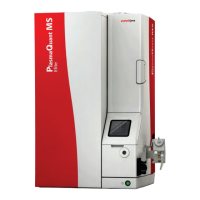PlasmaQuant MS product family Detector calibration
95
9.6 Attenuation factors calibration troubleshooting
If no significant sensitivity is observed for selected isotope/s when running the
detector calibration, then check the following:
Inspect the sample introduction system and verify that the detector calibration
solution is pumped into the spray chamber and the solution waste from the spray
chamber is drained out properly.
Make sure that a correct detector calibration solution is prepared and used. The
solution must contain the isotope/s selected for the attenuation factor calibration.
Verify that a correct worksheet is selected and re-tune the method parameters (if
necessary) to achieve an adequate sensitivity for the selected isotope/s, typically
over 10,000 c/s per isotope.
If no detector attenuation factor is calculated for some of the selected isotopes:
Un-calibrated attenuation factor is often due to a detector over-range. Open the
detector calibration worksheet, start the time scan from the method optimization
page (W
ORKSHEET EDIT METHOD OPTIMIZATION START), and ensure that the
sensitivity for the isotope of interest is not over-ranged; if required, re-tune the
instrument or, if necessary, dilute the appropriate calibration solution. One way to
work around this is to temporarily override the maximum count limit the detector
will accept without over ranging.
If the attenuation factors are not set up correctly, there is a possibility that your
attenuation results will not be linear for higher concentrations (meaning the results
from the instrument will not be correct). At very high count rates, the detector will
start to saturate and exhibit curvature as its response falls off the slope – although
it should read “over-range” before this occurs. The software assumes the data is
always linear when in fact it may not be in this case. You should independently
verify the linearity of your working concentration/ standards range when working
with higher concentrations.
If the %RSD for some of the factors are poor, typically over 5 %:
Ensure that the instrument achieved an adequate sensitivity for the selected
isotope/s, typically over 10,000 c/s per isotope.
Make sure the
DWELL TIME and SCANS PER REPLICATE are set up properly. It is
recommended to use 50,000 µs dwell time per isotope and use 50 scans per
replicate. Also, set the number of detector calibrations to be five from the
INSTRUMENT DETECTOR ATTENUATION window.

